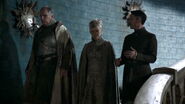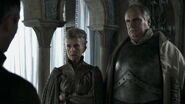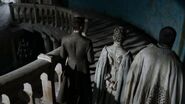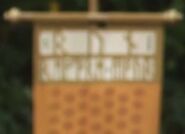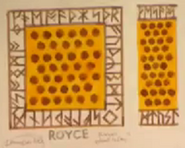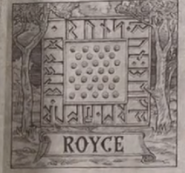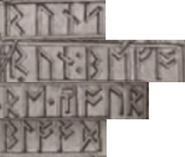 |
Although this page is based on canonical information, the actual name of this subject is pure conjecture.
|
- Gilly: "You know all that from staring at marks on paper?"
- Samwell Tarly: "Yes."
- Gilly: "You're like, a wizard."
- — Gilly is impressed by Samwell Tarly's mastery of the written word.[src]
Several different writing systems are described in the A Song of Ice and Fire novels, but because they are not a visual medium, they haven’t been described in any detail. George R.R. Martin did not invent his own writing systems the way J.R.R. Tolkien did for his fictional languages – because as Martin has repeatedly pointed out, Tolkien was a professional linguist, but he is not. The Game of Thrones TV series, however, as an adaptation into a visual medium, can actually portray different writing systems on-screen.
There are two major writing systems in the parts of the world visited by the narrative: the one used by the Common Tongue of the Andals in Westeros, and the Valyrian glyph system (or systems). A third system, the Old Tongue runes, was supplanted millennia ago by the Common Tongue, along with the spoken language, and few use it in the present day.
Old Tongue runes
The Old Tongue is the original language of the First Men, the first group of humans to migrate to Westeros. The novels describe it as having a basic rune-based writing system, but it was only used for basic tasks such as marking gravestones, not composing prose narrative books. It was supplanted by the Common Tongue of the Andals during the coming of the Andals six thousand years ago, and in the present day is very rarely used.
The North was the only region of the Seven Kingdoms that was not conquered by the Andals, but over the centuries through a process of cultural diffusion the Northmen adopted the language of their Andal neighbors, and along with it their writing system (this mirrors how medieval Scotland managed to rapidly build itself up into a strong kingdom capable of resisting invasion from England to the south by adopting many English cultural customs and administrative practices). The Order of Maesters did originate at Oldtown before the coming of the Andals, but apparently it was still largely an oral tradition – it is clearly stated that books were never written in Old Tongue runes.
In the present day, some of the Free Folk (wildlings) who live Beyond the Wall might still know the Old Tongue rune system, for basic tasks such as gravemarkers, but their tribal society is largely illiterate. In the novels, when Jon Snow hands the wildling clan leader Tormund a letter he tells Jon that he can’t read – though this is inconclusive, given that the letter was written in the Common Tongue writing system, which Tormund wouldn’t know even if he did know the Old Tongue rune system. Maesters still know the Old Tongue rune system, and those concerned with history use it in their research about the Age of Heroes, to glean what little they can from gravemarkers left by the ancient First Men.
The most prominent use of Old Tongue runes in the narrative is actually in the heraldry of House Royce, who are very proud of their descent from the First Men (being one of the only major First Men Houses that the Andals did not push out of the Vale when their invasion began there). It is also a tradition for the current head of House Royce to wear bronze armor inscribed with Old Tongue runes. The novels do state that the heraldry of House Royce contains Old Tongue runes, but gives no description of what they look like.
For the TV series, Old Tongue runes are depicted in the on-screen heraldry of House Royce. These first appeared on tournament banners in Season 1, and later more prominently appeared in Season 4 when Lord Yohn Royce, head of House Royce, wore a cloak with his House sigil prominently displayed upon it.
The rune symbols in the TV series appear to have not been invented from scratch, but are simply a re-use of the real-life Anglo-Saxon Furthorc rune system. The Old Tongue language, however, had not yet been invented when this heraldry was designed in Season 1 (and really, only first received even a brief sampling in Season 5), so the actual words spelled out by the runes are in English/Common Tongue.
The sigil of House Royce contains four strings of runes, one around each side. They don't inherently need to form a complete sentence and in-universe might just be a series of abbreviations, etc. Nonetheless, using real-life transliterations of the Anglo-Saxon Furthorc alphabet, the runes in the sigil actually do seem to convey meaning, instead of just being a random string of characters:
The top line (the only one easily readable without tilting your head) transliterates as "RUNS" - perhaps a contraction of "RUNeStone" (Runestone), the castle-seat of House Royce.
The next three lines, proceeding clockwise, actually do seem to form a coherent sentence:
- RUN:BEFO
- RE:YOUR
- BLOOD
Written out longways, including the punctuation breaks, it spells out "Run before your blood" - which certainly seems to be a coherent message instead of just random characters. The full meaning is apparently along the lines of "Run (from our war banner) before (we spill) your blood".
Common Tongue alphabet
Work in progress
Overview: In the novels
The Common Tongue of the Andals is the primary writing system used in Westeros. It was introduced to the continent 6,000 years ago during the coming of the Andals. The spoken and written forms of the Andals' language supplanted both the spoken Old Tongue of the First Men and its rune-based writing system. While the Old Tongue was only employed for simple uses such as carvings on grave markers and the like, the Common Tongue was the first truly widespread writing system introduced to Westeros, used for everything from book creation to written letters sent by messenger-raven, ale-house signs, etc. A possible reason for this is that the religion of the First Men, worshiping the old gods, was based entirely on oral tradition and had no holy texts whatsoever, while the Andals' religion, the Faith of the Seven, is based around a central holy text, The Seven-Pointed Star. Part of their society was thus always responsible for recopying and disseminating written texts, and in time this apparently spread to secular uses such as business records, contracts between lords, history books, etc. It was apparently at this time that the Order of Maesters established the system of sending messenger-ravens from one castle to another to deliver messages that he been tied to their legs.
It is a conceit of the narrative by George R.R. Martin that the "Common Tongue of Westeros" (the language of the Andals) is exactly like modern English, both in spoken form and written form. Martin has repeatedly emphasized that the world that Westeros and Essos are set in is simply an alternate Fantasy world, unconnected to real life, and not the real life Earth in the distant past or future. This is in contrast with several other Fantasy series set in the distant past of actual Earth (Tolkien's Lord of the Rings), an alternate dimension/plane of existence accessible from real life Earth (C.S. Lewis's Chronicles of Narnia), or set in the distance future of real life Earth (Robert Jordan's Wheel of Time series, Terry Brooks's Sword of Shannara series, Anne McCaffrey's Pern series, Pendelton Ward's Adventure Time, etc.). The "Common Tongue" of Westeros just happens to be exactly like modern English - just "because", to make it intelligible and relatable to Martin's readers.
Overview: Handwriting in the TV series
The TV series, unlike the novels, has to visually portray the writing system of the Common Tongue - introducing the nuance of what specific handwriting styles are used by the production team. Similar to the Heraldry and Costumes which can now be presented in the visual medium of the TV series, while they aren't connected to real life Earth's medieval period, these visual designs are meant to be loosely inspired by medieval designs, or alternate pseudo-medieval designs.
The handwriting styles used in the TV series were developed by graphic artist Jim Stanes, and also worked on by graphic artist Michael Eaton. In the "Anatomy of an Episode" Blu-ray featurette for the Season 1 episode "A Golden Crown", during the scene in which Eddard Stark reads through the Lineages book and realizes that Joffrey isn't really Robert Baratheon's son, Stanes briefly gave some commentary about his work on it and the TV series in general. Stanes explained that in the TV series he developed "A sort of semi-medieval, an adaptation of medieval handwriting. Something that I can do comfortably and quickly."
From his comments, several general observations can be established about the different handwriting styles used for Common Tongue writing in the TV series:
- The handwriting is meant to be pseudo-medieval, inspired by parts of real medieval handwriting styles, instead of just typing out a modern font. Every page has to be written by hand by graphic artists in the production staff.
- It isn't actually as complicated as entirely accurate medieval handwriting, because the graphic designers have to be able to write out a large amount of material reasonably quickly and on a deadline.
- It has to be generally legible to the TV audience in closeup shots - therefore, it is simplified to resemble modern handwriting practices to a greater extent than was actually used in the real Middle Ages.
Regarding this last point, the handwriting in the TV series was simplified in several ways from actual medieval use:
First, it does not use some of the more complex contraction symbols that actual medieval handwriting used. For example, an ampersand symbol "&" means "and" because it is a contraction symbol for "ET", which is Latin for "and" - this is not immediately obvious to TV viewers. Actual real-life medieval handwriting used many more contraction symbols, many of which are no longer used in modern writing systems (such as the Tironian notation, developed by Cicero's secretary Tiro). The pages in the TV series have to be readily understood at a glance, however, so these contractions are not used. Real medieval handwriting used many contractions both for speed and as a cost-saving measure - without paper, the writing material they used was parchment, made out of animal skin, and therefore relatively expensive (usually parchment was made out of sheepskin, though sometimes out of more expensive cattle-skin/vellum - Ireland was an exception; as a major cattle-producing region it used vellum quite frequently). Medieval monks, chancery clerks, and other writers therefore often tried to fit as much as possible onto a single piece
Next, real medieval handwriting didn't use capital letters for the first letter of proper nouns or the first word beginning a sentence the way that modern writing practices do. Instead, "capital letters" (called "majuscule") were an entirely different font/handwriting style from "lowercase letters" (called "minuscule"). Majuscule was more of a "display font", used for important purposes: either in very expensive and slowly produced high-quality books, or more often, as the carefully written title of a book given on the cover or first page. For example, the title page would be written as "GAME OF THRONES" in all-capitals, but in the body text be written as "game of thrones", all in lowercase. If it was the title or a section title, Ned's name would be written as "EDDARD STARK", and in the body as "eddard stark" - but not as "Eddard Stark", with the first letter of each word in a proper name capitalized. In contrast, the handwriting actually used in the TV series does use modern capitalization standards, to make it more readily legible for viewers - the name is never written as "eddard stark", and usually as "Eddard Stark" (rarely, when used as a section name such as in the Lineages book, it will be written out in an all-capitals display font as "EDDARD STARK". Moreover, these all-capitals majuscule display fonts were practically artistic expressions, and could be much more variable than the more systematized regular handwriting used in the rest of a book.
Handwriting in the TV series also mercifully does not employ scripta continua - writing all of the words in a text without any spaces between them (like "gameofthrones"). Originally, as a space-saving measure, the Romans wrote Latin this way, and from context they were able to sound out where one word ended and another began. This continued into the early medieval period. As the Middle Ages progressed, however, languages diverged into vernacular forms and Latin was no longer spoke as a birth language. Many of the early centers of monastic writing developed in medieval Ireland, which didn't even speak a vernacular Romance language derived from Latin at all, but medieval Celtic. It therefore wasn't immediately obvious to Irish monks when one word in Latin ended and another began, so they invented the practice of separating different words in a text with spaces, a practice which was adopted by the rest of Western Europe for greater clarity. Scripta continua wasn't use very frequently in the second half of the Middle Ages, however, when the large bulk of medieval writing was produced (in the Carolingian hand after 800 or Gothic hands after 1100, etc.)
Finally, real medieval handwriting was predominantly done in Latin, not in vernacular languages, and certain letters didn't exist in Classical Latin, specifically "j", "k", "u" and "w", "y", and "z". Certain earlier medieval handwriting systems, therefore, simply didn't have widespread forms for these letters - though they are sometimes encountered in the later hands. The sounds of "i" and "j" are both formed similarly by the mouth, and the "j" sound (like a soft-G, like "jam") simply didn't exist in Latin - thus when Latin was used for sounds from other languages, "i" was used for both the "i" and "j" sounds. The letters "k", "y", and "z" were from the Greek alphabet, and could be encounters in Latin texts in direct loanwords from Greek, but they were largely redundant: "c" in Latin was always hard, never soft like "s", so there wasn't really a need for "k" ("Stark" can easily be spelled as "Starc"). Medieval Latin used these letters somewhat more due to the influx of Greek vocabulary from the New Testament used in bibles (i.e., "baptize" with a "z"). The Romans didn't really differentiate between "u" and "v" in spoken Latin, and didn't have a "w", so initially all of these sounds were represented by "v" (in fact, the sound "v" made in Classical Latin was actually close to that of a modern English "w": thus when Caesar said "Veni, vidi, vici", this was actually pronounced "Weni, widi, wici"). As the Middle Ages progressed, however, people started outright writing in vernacular instead of Latin, or to accurately represent Germanic names in Latin texts. This necessitated a differentiation between "u" and "v", and to invent the letter "w" (literally "double-u", written as two overlapping "u" letters next to each other). The TV series writes out messages in modern English, however, so all 26 letters in the modern English alphabet exist.
Another major feature of post-Roman, medieval handwriting, was "tall S" - an "S" written so tall that it rises above and below the other short letters such as "n", and which is so horizontally condensed that the bows aren't even clear - in short, "tall S" is easily mistaken for a modern, uncrossed "f". A rounded, more modern-looking "s" was only introduced in the Gothic system used after 1100. For the sake of clarity, the TV series avoids "tall S" entirely, instead using medieval round "s" which looks more like the modern forms that viewers would be familiar with.
Handwriting in the TV series also generally uses modern punctuation marks, which weren't used early in the Middle Ages but were gradually introduced over the centuries. For example, the question mark "?" was only invented by Alcuin of York in the 800's, and it took many centuries to enter into widespread usage.
Overview: The development of different medieval writing scripts
Medieval handwriting moved through four major phases, prior to the Renaissance, when non-medieval "Humanistic" scripts were introduced. These phases are the old Roman system, then the National Hands, then Carolingian minuscule, and finally the Gothic scripts.
The Roman system included Square Capitals, Rustic Capitals, Old Roman Cursive, Uncial, Early and Late Half-Uncial, and New Roman Cursive. After the fall of Rome handwriting chaotically diverged into several National Hands, of which there were (broadly) four. Merovingian minuscule was the script mostly used in the domains of the Franks, from modern France and Germany to northern Italy. Out on the fringes of Western Europe, not controlled by the Merovingian Franks, the other National Hands developed: Visigothic script in the Christian-held lands of northern Spain, Benevetan script in southern Italy, and "Insular" script in the British Isles. "Insular" may well be called "Irish" script: after the pagan Anglo-Saxons invaded literate culture died out in England for two centuries, while "Insular" script developed in the monasteries of Ireland. Irish missionaries later reintroduced reading and writing to barbarian England, and thus England used the unique Irish handwriting style (which had been influenced by local Gaelic symbols).
There was a revival in learning under Charlemagne after 800, and a massively successful reform of the writing system, producing Carolingian minuscule. Carolingian minuscule replaced Merovingian minuscule, and then gradually edged out Visigothic and Insular scripts (though Carolingian minuscule produced in the British Isles still retained a noticeably more prickly shape to it than in the rest of mainland Europe - a lingering hint of Irish influence). Beneventan script continued to exist in southern Italy, side by side with Carolinngian minuscule, and was thriving as late as the 11th century.
Starting in the 1100's, there was a new growth in literate culture, due to various factors such as more centralized powerful kingdoms, the establishment of the first universities, and rising trade (the "Renaissance of the Twelfth Century"). This gradually led to the development of the "Gothic" system of scripts. Gothic was ultimately used across all of Western Europe, with no other rival handwriting scripts - from Spain to France to England, "Gothic" was the same international script (with the minor exception that, due to Beneventan lasting the longest of the other scripts, it slightly influenced Italian Gothic hands, which continued to have a slightly more rounded and broad appearance than Gothic scripts produced elsewhere).
When Carolingian script replaced Merovingian script, it was as the result of a concentrated and sudden effort at systemic reform. In contrast, "Gothic" just gradually evolved out of "Carolingian" in slow phases - the basic letter forms are the same, but their proportions are different (for example, Carolingian "a" has a slanted back, but Gothic "a" has a more formally written, straight back). Gothic is also more tall, narrow, and oval-shaped - a space-saving practice, due to the larger amount of writing now being produced. The result of this is that it is at times difficult to differentiate "Late Carolingian" from "Early Gothic" - and it is now generally accepted by medievalists that there can be said to have been an intermediate stage loosely called "Proto-Gothic" - hazily defined as Carolingian that uses certain Gothic features but not all of them consistently (with outright "Gothic" firmly established by 1200 in most regions). There are two telltale features of Gothic text script that are not in Carolingian: first, if two bows are together they will overlap (the "pp" in "apple" will touch instead of being written separately), another space-saving move. A second space-saving feature introduced in Gothic is that if "r" appears after "o", to use a scrunched "2-shaped r" written as a cursive ligature (linkage) with the "o".
Another development of the Gothic system was the revival of cursive scripts. While the Romans had a distinction between text-scripts for books and cursive scripts for everyday handwriting, this collapsed after the fall of Rome. The National Hands and Carolingian had ligatures (linkages) but weren't purely cursive hands - so little writing was being done before 1100 that it was only for formal uses such as making religious texts, but the rise of literate culture and trade again after 1100 meant that writing was now being used for more everyday uses, which more emphasis on speed than clarity. Besides the Gothic Text script, there were several Gothic Cursive scripts. One of the first was "Anglicana", starting in the late 1100's. It was used by the Anglo-Norman kings, and ultimately under Henry II throughout the "Angevin Empire" stretching across England, Ireland, and much of northern France. Even the core regions of Capetian France under Phillip II Augustus came to use Anglicana. After 1300, however, France began using its own French "Secretary" hand (Anglicana "d" leans right, but Secretary "d" leans left).
There were also subtle gradations between Gothic Text and Gothic Cursive. What makes a script "cursive" is when the letters actually link, without lifting up the pen. Some Gothic Cursives became adopted to such formal uses that they were developed into "Gothic Hybrid" scripts: fundamentally "text" and not "cursive" because the letters aren't linking, but using cursive letter forms. Meanwhile, very formally written Gothic Cursives that were so easily legible that they approached Gothic Text came to be known as "Gothic Bastard scripts" (they were almost text, but not quite, just as a bastard son is a step below a legitimate son). The actual difference between "Gothic Bastard" scripts and just plain "Gothic Cursive", however, is somewhat subjective (unlike the clear difference between Text and Cursive, or Text and Hybrid). The entire continuum therefore ran from Gothic Text to Hybrid to Bastard to Cursive.
Carolingian used a capped "a" (with an open bow on top), while Gothic Text shifted to use a peaked "a" without any cap to it. Gothic Anglicana Cursive, however, continued to use a capped "a" and was very widespread, though French Secretary hand used a peaked "a".
Scripts used in the TV series
Jim Stanes said that the handwriting used in the TV series is "A sort of semi-medieval, an adaptation of medieval handwriting."
Several different handwritings are used in the TV series, but they are all essentially simplified variants of Proto-Gothic.
The handwritings used in the TV series never actually existed in real life, but are essentially simplified Carolingian minuscule using a few - but not all - features from Gothic. Unlike the difference between Carolingian and Merovingian, however, there actually was a loosely defined intermediate stage between Carolingian and Gothic. Therefore, "a Carolingian script that uses a few Gothic features" would best be categorized as (loosely) "Proto-Gothic" (which in real life would date to roughly 1150-1200 or so).
Absolutely none of the scripts from the Roman system or National Hands have ever been used in the TV series. The four National Hands are easy to distinguish: Merovingian uses "oc"-A - a lowercase "a" with no cap and a tail so long it looks like an "o" followed by a "c" and overlapping - also, Merovingian "oc"-A has an open bow to it (nothing in the TV series uses an open-bow "a" like this). Visigothic script distinctively continues to use a capital "G", instead of a lowercase "g" like these and all later scripts (nothing in the TV series does this). Beneventan script uses "oc"-A with a closed bow (which nothing in the TV series does), and also very distinctively has a short, squat "t" with a very long loop on the left side - so large, in fact, that the letters "a" and "t" in Beneventan look almost the same and can be easy to confuse (as in pater, "father"). Insular script has a very distinctive flat-headed lowercase "g", which doesn't even have a bow (a very advanced form brought to Ireland by Roman missionaries, based on the so-called "Quarter Uncial", a handwriting of educated men in the late Roman Empire). None of these Roman or National Hands appear in the TV series, only variant forms on the spectrum between Carolingian and Gothic.
While all 26 letters in the English language appear on-screen in the TV series, all of them don't really need to be compared between one script and the next: a "c" shape is basically the same thing between one script and the next (as it is generally similar in the real life medieval hands). There are five letters whose forms diverge the most between one hand and the next, which can be focused on for analysis: a, d, g, s, and t. Also, "g and y" form one category, because in these scripts "y" is always written as just an open-bowed "g", the tail shape is the same (unless otherwise noted).
By cross-referencing the differences between how these five letters are written on different props throughout the TV series, about ten to twelve variant scripts have appeared in the TV series through the end of Season 5.
Lineages hand
- a - capped, slanted
- d - curved to simple uncial
- g and y - complex to simple curve
- s - angular, tall, breaks baseline and head
- t - uncial
Ramsay's letter to Balon
Rather unusually, this is the most formal script ever used in the TV series, closely resembling Gothic Text. Lines are very straight, bows in "a" and "o" are nearly hexagonal.
Yet there are several features which would never be used in a formal Gothic Text script: uncial (uncrossed) T instead of a distinctive crossed Gothic "t", the unusual "complex g", and an "f" that descends below the baseline. As a strict rule, "f" descends below the baseline in Carolingian minuscule, and it also descends below the baseline in Gothic Cursive, but it never descends below the baseline in formal Gothic Text script (it's one of the major points that distinguishes Gothic Text from Gothic Hybrid script).
Ramsay probably didn't write this himself, but may have dictated it to a maester, whom he instructed to write it very formally, given that it was an important formal declaration to the leader of the Iron Islands.
This is one of the few scripts seen in the TV series that uses peaked "a" instead of capped "a" (which otherwise is one of the features of very formal Gothic Text that separates it from Gothic Cursive).
- a - peaked, straight
- d - rounded uncial
- g and y - complex
- s - round
- t - uncial
Ramsay's letter to Robb
Samwell's hand
- a - capped, slanted
- d - straight-backed (Samwell), curved uncial (letter to Tywin)
- g and y - straight then sharp angle, can be squiggly
- s - round, descending below the baseline
- t - uncial
Littlefinger/Shireen book hand
Jorah's pardon
Beric's IOU
Robb Stark's cursive
Theon Greyjoy's cursive
Book of Brothers
The Book of Brothers was actually written by many different people across the generations. It is the duty of each successive Lord Commander of the Kingsguard to record in it all of the deeds done by the seven Kingsguard during his tenure (including his own deeds). As a result, the handwriting style shifts every time a Lord Commander dies - Gerold Hightower logically couldn't record his own death, so the novels note that under Ser Gerold's entry, the final paragraph describing his death shifts to the hand of his successor, Ser Barristan Selmy.
Valyrian glyphs
The old Valyrian Freehold ruled much of Essos for thousands of years, half the known world, but it fell in the cataclysmic event known as the Doom of Valyria four centuries before the War of the Five Kings. Essentially analogous to the Roman Republic from real life, the Valyrians imposed their language - High Valyrian - and presumably its writing system across their domains. After the fall of Valyria, the High Valyrian spoken language evolved and diverged in their former colonies into the various Low Valyrian languages (one in each of the Free Cities, and another in Slaver's Bay.
In the novels, the Free Cities are still described as using a writing system based on "Valyrian glyphs", though no description of it has been given. For that matter, it isn't clear if there is still one system, or if it diverged into several variant systems after the fall of Valyria.
David J. Peterson, the official linguist on the TV series who developed the Dothraki and Valyrian languages, has not yet created an official Valyrian glyph writing system. Through Season 5, the TV producers hadn't asked him to write any Valyrian writing props yet, and he isn't going to invest the time in developing it unless he knows it will actually appear on-screen (similarly, the TV producers never asked him to include any of the Braavosi Low Valyrian spoken language in episode dialogue, so he hasn't invented that language yet). Peterson does look forward to being able to invent the Valyrian glyph writing system, and he has invented writing systems for several other projects he has worked on. As Peterson said in April 2013, for a High Valyrian writing system he "was thinking something more like Egyptian’s system of hieroglyphs—not in style, necessarily, but in their functionality. Egyptian had an alphabet, of sorts, a couple of phonetically-based systems, and a logography all layered on top of one another."[1]
There were two points in Seasons 1 to 5 when the TV show could have used Valyrian glyphs but chose to just use the Latin/Common Tongue alphabet instead. In Season 3's "The Bear and the Maiden Fair", Talisa is writing a letter in Valyrian to her mother in Volantis, but writes it using Common Tongue letters - albeit in an unusual foreign handwriting style. Peterson commented on this and said that because the letter only briefly appears on screen, it simply didn't merit the amount of work needed to develop a new writing system for it: "it didn't seem worthwhile to create an entire writing system for what ultimately is kind of a throwaway shot".[2]
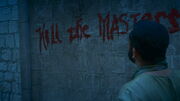
"Kill the Masters" graffiti in Meereen, incongruously written in the Common Tongue of Westeros.
The second instance was in Season 4's "Oathkeeper", when the episode quite prominently focuses on graffiti in Meereen that reads "Kill the Masters" - written not only in the Common Tongue writing system of Westeros, but spelling out the spoken version of this phrase in the Common Tongue/English. Peterson commented on this, and said he pointed it out to the producers when he was shown the script for the episode, feeling it was incongruous that protest graffiti in Slaver's Bay would use the Common Tongue of Westeros. He shared that the specific message he sent to the producers was: "There's a scene where we see 'Kill the masters' graffitied on the wall. Fans of the books will be expecting to see this in Valyrian glyphs as opposed to English characters, but thus far we haven't discussed creating a writing system for Valyrian. This is something I'm able and willing to do (I created the writing systems used throughout Defiance), and can do if D&D are interested." The producers apparently wanted the viewers to be able to read the graffiti. The "Kill the Masters" graffiti reappears in Season 5, and in Season 6 as well.[3]
It isn't clear if all of the former domains of the Valyrian Freehold still use the same High Valyrian glyph writing system. The Valyrian Freehold was analogous to the Roman Republic, and after the fall of Rome in real life, handwriting styles diverged in the former Roman domains (Italy, Spain, England) that used the Latin alphabet, but there wasn't a shift to entirely new writing systems. The western half of the Roman Empire didn't really have a widespread indigenous writing system before being conquered by the Romans, so it was easy to impose the Latin writing system in those areas - and after its fall, the Germanic invaders that migrated into the lands of the fallen western Empire didn't have a strong literate culture either, so the Latin alphabet continued to be used as the main writing system. In contrast, the Greek-speaking eastern half of the Mediterranean continued to speak Greek after being conquered by the Romans, and because it already had a strong literate culture, the Greek writing system wasn't displaced by the Latin writing system.
In the novels, the Ghiscari Empire assuredly had its own writing system before being conquered by the Valyrians. The Valyrians did impose their spoken language on the Ghiscari city-states in Slaver's Bay, to the point that even after the fall of Valyria some 5,000 years later, the local elites continued to speak a form of Valyrian, because the Old Ghiscari language had long since died out. It is possible that after being conquered by the Valyrians, Slaver's Bay spoke Valyrian but wrote it using the Ghiscari writing system, but given the extinction of even the spoken Ghiscari language, it seems more probable that the Ghiscari writing system died out as well (though it may have influenced the handwriting styles used in Slaver's Bay).
To the west, the southern Free Cities (Volantis, Lys, Myr, and Tyrosh), were founded as direct colonies by Valyria, so they apparently didn't have any indigenous writing systems to compete with. In the north, Norvos, Qohor, and Lorath were also founded as direct Valyrian colonies. There is some indication that Pentos actually predated the Valyrians, and was an Andal city-state they conquered - in which case the Common Tongue alphabet might have influenced their handwriting style.
Braavos would have the most reason among the Free Cities to have a divergent writing system, being founded by a diverse group of slaves who escaped from Valyria, but even so, in the novels it is described that when Arya Stark arrives in Braavos, she sees ship names written on the sides of their hulls in Valyrian glyphs. The founders of Braavos were escaped slaves from many different lands (Summer Islanders, Rhoynar, Ghiscari, Andals, and others), but their only common language was Valyrian so they continued to speak it (diverging into Braavosi Low Valyrian). They probably continued to use the Valyrian glyph writing system for similar reasons. The diverse background of the Braavosi, however, may have influenced local handwriting styles (this may have also happened in Lorath to an extent, which became a haven for runaway slaves, some of whom may have been literate and from other far away lands).
Other writing systems
Other cultures and language groups in the known world probably have their own writing systems, but they've barely been described in the narrative: the major writing systems to focus on are Common Tongue (which uses the Latin alphabet and is spelled like English, just as a Fantasy conceit), Old Tongue runes, and the extensive Valyrian glyph system m (or family of systems). Again, it isn't clear if the original High Valyrian glyph system used from Pentos to Meereen later evolved into variant forms after the Freehold's collapse.
Other writing systems can only be briefly touched upon:
The Dothraki are officially an illiterate society that has no writing system, relying entirely upon oral tradition.
The Rhoynar (ancestors of the Dornishmen) used to have prosperous mercantile city-states along the Rhoyne River in the region of the present-day Free Cities, and presumably they must have used their own writing system. The Valyrians did not conquer and incorporate the Rhoynar city-states and local elites, however, but left their cities in ruins, and enslaved the survivors, so their own rival colonies (the Free Cities) could dominate the area. The Rhoynar writing system therefore apparently went extinct, and didn't influence later writing systems used in the Free Cities. Those Rhoynar that escaped by fleeing to Dorne a thousand years ago converted to the spoken language, writing system, and religion of the Andals in Westeros, abandoning any previous Rhoynar systems as well (though whatever writing system the Rhoynar used might have influenced the specific handwriting variant used in Dorne, combined with their long independence from the Iron Throne).
It isn't mentioned what writing system Qarth uses. They do trade with Slaver's Bay and the Free Cities, and indirectly with Westeros, and its merchants are at least familiar with Valyrian spoken languages and the Common Tongue of the Andals, so logically they are probably at least familiar with those writing systems (i.e., if the Lannisters sent a letter to Qarth asking to purchase silk, the Qartheen merchant guilds would be able to understand it).
The Summer Isles apparently have their own writing system, as mention is made of histories carved into the trees at their temples; but otherwise they seem to prefer using oral histories, recorded in complex rhyming couplets to aid memorization (like real life West African griots). The Summer Islanders are very active maritime traders with an extensive merchant fleet, and Summer Islander ships have been observed from King's Landing to Braavos to Qarth (in fact, the ship seen in Qarth later went to Braavos, then to Oldtown). Summer Islander crews therefore generally seem to be conversant in a variety of languages, and their captains can probably read contracts written in their associated writing systems.
Yi Ti has a very extensive literary culture, the eldest in the world, stretching back continuously to almost the time of the Long Night itself 8,000 years ago. Literacy is a highly praised cultural value in Yi Ti. Their scholars closely guard their precious ancient scrolls, however, and rarely let maesters from Westeros have access to them. The novels haven't described the Yi Tish writing system at all.
The TV series actually invented the secret code-language script known only to Catelyn and Lysa Tully, a game from when they were children, apparently for the unscreened pilot. It never actually appeared on-screen in the final version and now likely never will. Logically, it may have been too confusing to introduce in the very first episode an invented script which isn't actually a widely used writing system, which would only be used that once, and then never seen again. Nonetheless, production images were circulated of the actual prop letter. It is no longer of any widespread use in-universe, was only a private code-language, and given that it never appeared on-screen it might not be fully canon - however, it does provide an out-of-universe insight into the work that is devoted to prop production.
As for the non-human races, the giants don't have the intellectual capacity for written language, or even complex spoken language (they can talk, but their speech is a simplified pidgin of Old Tongue - they have the intelligence of small children). The Children of the Forest don't seem to have had any writing system - they didn't need one. Their greenseers used their magical powers to directly view the past. The spoken language of the White Walkers has barely been mentioned, only that it sounds like the cracking of ice. The TV series came up with the name "Skroth" for it, but it is developed with sound effects, impossible for a normal human to pronounce. George R.R. Martin has said that the White Walkers are a magical, entirely different kind of "life" altogether, separate from life as we know it, and that they might not even have things like a material culture in the sense that we understand it. They remain utterly enigmatic. Therefore, whether Skroth has any sort of writing system associated with it is also unknown.
References
- ↑ Dothraki.com, David J. Peterson's blog, April 10, 2013.
- ↑ Dothraki.com, David J. Peterson's blog, May 13, 2013.
- ↑ Dothraki.com, David J. Peterson's blog, January 12, 2014

